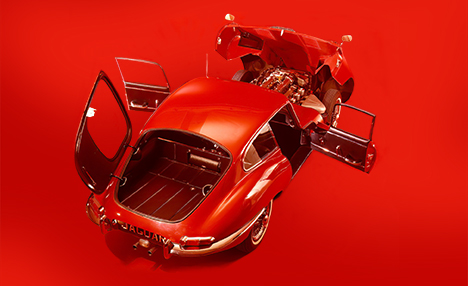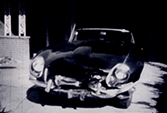 I had my first glimpse of a Sprite during the winter of 1958. John Thornley, MG factory boss and BMC Competition Department instigator, heard that I was writing “Modified Motoring,” a tuning book on the A series Austin A35 and Morris Minor. He invited me to an early showing of the Bugeye so that I could include details in the book.
I had my first glimpse of a Sprite during the winter of 1958. John Thornley, MG factory boss and BMC Competition Department instigator, heard that I was writing “Modified Motoring,” a tuning book on the A series Austin A35 and Morris Minor. He invited me to an early showing of the Bugeye so that I could include details in the book.
I was just starting my first year as a works driver for Abingdon when Marcus Chambers, the Competition Department manager, loaned me a car to prepare in my Speedwell shop and run in international events. He didn’t think that such an underpowered car had much hope of success in the competition field, but hoped that our tuning and private entry might give a class win or two at little cost to his department.
Within a couple of months, Bugeyes were winning club rallies, won an International GT Race in Ireland and took the first three places in class on the tough Alpine Rally, which climbed several towering mountains in the Dolomites to over 9,000 feet. Sprites were also dominating the 1000cc class in Sports and GT races. The 1959 season started with a second in the GT category at the Monte Carlo Rally, this time as a works entry finishing 14th overall out of several hundred starters, which included around 16 three-car factory teams.
Sprites took the first three places in class at Sebring in the U.S. A Sprite won the 1959 British Rally Championship and British Trials, plus the Rally Drivers Gold Star Championship, culminating with a class win at the rough, fast and dusty four-day Liege-Rome-Liege Marathon. A works Sprite was also second overall at the British RAC International Rally, a feat that it repeated the following year, as well as a third place overall at the Liege in 1960.
The list of successes goes on and on, and 50 years later, the Sprite is still considered to be the leader among small GT cars in classic and vintage races and rallies. On recent trips to Goodwood in the U.K. and Road America in the U.S., I saw highly modified Sprites vying for first place in unlimited size GT events. The many versions built by specialist firms like my Speedwells and Sebrings, Ashleys, WSM and even sophisticated models raced by the Donald Healey Company itself shows how the tuning profession took to Donald’s “frog”—even if, at the time, those stick-up headlamps didn’t win many friends.
The affordable Sprite enabled thousands of enthusiasts all over the world to take part in competitions that had previously only been the prerogative of the rich, including me. A full Sebring Sprite with steel body could be bought new for around 1500 pounds sterling with every listed mechanical option, including discs, tougher close ratio gears, wire wheels, and engine modifications for race or rally.
The first such model, purchased in the summer of 1960 by John Patten, was the third place car at Liege among an entry list of Porsches, Alfas, Ferraris, works Healey 3000s and other expensive factory entries.
Geoff Healey and his crew designed a truly brilliant and forward-thinking body shell, in fact an early monocoque. But naturally, BMC searched the parts bins for the bits and pieces of power, drivetrain, braking, steering and suspension in order to keep the price as low as possible.
The gearbox was a horror; I cannot tell you how many crates of busted first and reverse gears were stacked under our workbenches. Front stub axles were also too frail for the job. BMC’s chief designer, Syd Enever, told me that the two holes drilled into the stub had no place on the production run and were almost certainly the cause of the weakness. In true BMC style, they were still drilled–and failing–when I tackled the London-to-Sydney Marathon 10 years later in a Spridget, which shed its front wheel through stub failure as we crossed into New South Wales, the last state in a 10,000-mile event. More galling was the fact that we were leading the private owner category and were in position for a top-10 finish.
The rear suspension with unusual quarter elliptic springs was sensational. It had tremendous road holding ability, and when coupled with a stiff front anti-roll bar, gave excellent adhesion even with a beam axle and no limited slip differential.
Braking was surprisingly good in the Sprite even with the original drum brakes, as long as the rather cheap production linings were changed to VG95s. The conversion to a Girling disc brake front setup with rear brakes from the Riley 1.5 transformed the stopping power to equal almost every high-end GT car in the world. Outbraking and outcornering far bigger GT cars became the hallmark of the Bugeye in the seasons to come.
Getting out the spare wheel would have been a lengthy disaster, but luckily punctures were somewhat rare, and mainly affected those who liked to slide the back end too close to the rough edges of the road. I think I only had five punctures in 20 years or so of racing and rallying. Nowadays tires seem to be changed every hour during an event, and the adhesion of modern sticky rubber no doubt puts a lot of extra strain on the suspension. My drive a decade ago at the Lactos Rally in Tony Bennetto’s Sprite showed just how different the driving techniques are with these new “stickies.” Braking distances were incredibly short and our old-fashioned technique of tail-sliding was virtually impossible. It took the first day to get used to a car that didn’t slide all over the road; I reckon I was braking far too soon even on day three!
My only real complaint about those early Sprites was the choice of colors. I don’t know who chose BMC’s palette, but the range was pretty much dull, duller and dullest. Speedwell Blue was the best of a bad bunch and is the colour of my own Bugeye, which has been my only road car for the last 15 years here in Hawaii. It carries the registration plate PMO 200, which was on that first Sprite I drove out of the factory a few days before the official launch of Britain’s arguably most successful production competition car.
By John Sprinzel







'Spritely Beginnings' have 2 comments
February 8, 2013 @ 7:33 am Chris Bardwell-Jones
I bought my first Sprite, a ’59, in 1966 while I was still an impoverished student. I fell in love with it and my girl friend fell in love with it and that became the catalyst for a marriage that is still in top gear today! Alas, when children appeared on the scene the Sprite had to go but the love endured and about 6 years ago we saw a ’60 Frogeye, the love was instantly rekindled and with not thought of haggling we bought it. Of course, beneath the shiny red paintwork there is a litany of chores that will demand our attention for evermore but it’s all a small price to pay for the opportunity to recapture our youth!
Over the last 45 years or so I have owned a wide spectrum of vehicles from tractors to SUVs to Jaguars but nothing, absolutely nothing, compares with the fun of hammering down the road in a Frogeye Sprite! The total sensory package of sights, sounds, smells, touch and feel is incomparable!
Gerry Coker and the Healey really hit the jackpot with this car. There is a strong consensus that claims that the E-Type was the finest car of all time (and I’m not a strong opponent of this view) but The Frog has a unique place in the hall of fame that even Jag fans cannot deny. Have you ever noticed that if you squint while looking at an E-Type it looks remarkably like a Sprite? It makes you wonder where Jaguar got their inspiration!
February 8, 2013 @ 8:59 am Joseph Viola
dear john, thanks for the history and your personal love affair with the “little lovely lady” Miss Bugeye. we love then no matter what! I’m in the process of putting together a 1961 bugeye that a former club member started. He owned Sprites for over 50 years. the club member passed on and hopefuily I can do honor to his devotion towards the little lady. regards, joseph viola